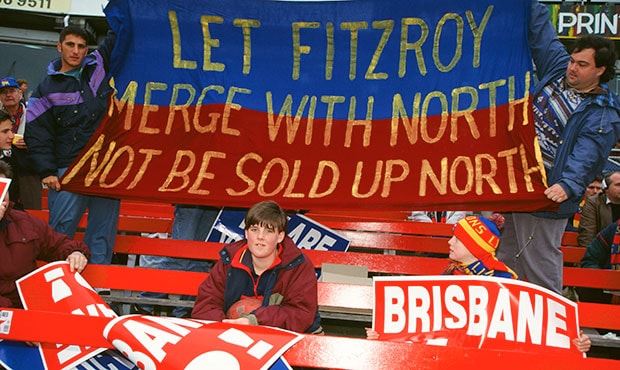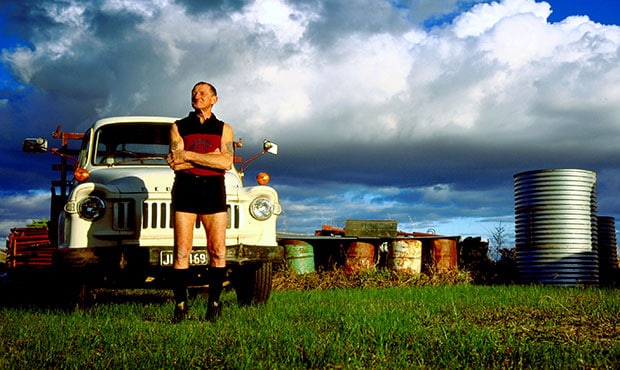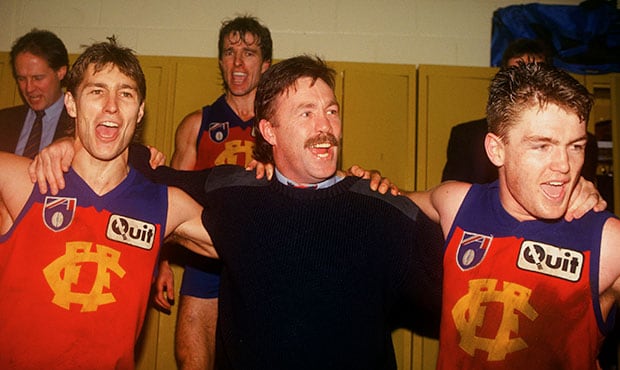FITZROY people – players, coaches and supporters – have a variety of opinions and theories about why there is no longer a Fitzroy, at least at AFL level.
And this weekend marks a good time to revisit the dark final few years of the old Fitzroy as the Brisbane Lions take to the MCG on Saturday night in a commemorative jumper ahead of a Hall of Fame event in Melbourne later that evening.
Fitzroy played its last VFL/AFL game in 1996 against Fremantle at Domain Stadium. The end was incredibly sad and the Lions were farewelled with dignity by the Dockers, as they were the week before when they played their final game in Victoria at the MCG against Richmond in front of 48,884.
But the end came as blessed relief for most Fitzroy types. The battle for survival was long and bloody and exacted its toll on pretty much everybody.
"Like a sick dog," said Matthew Rendell, a former Fitzroy captain. "It was almost like 'please put us out of our misery.'"
And it was a long, slow death. As far back as 1962, Lou Richards wrote of his fears for Fitzroy in his autobiography Boots and All, "Where they are headed for I'd hate to hazard a guess – I feel the future of Fitzroy is none too secure. They are hemmed in between two of the strongest clubs in the League in Collingwood and Carlton."
Who would have picked that 'Louie the Lip' would prove to be so sage? The great man ended up getting it right as after they left the Brunswick Street Oval at the end of 1966, the Lions passed through Princes Park (twice), the Junction Oval, Victoria Park and the Whitten Oval before, mercifully, the administrators were called in during the 1996 season.
Training and administration were equally nomadic. After leaving the Junction Oval in 1985, where at least the players had an indoor gym and their own lockers, they decamped to Northcote where the players hung their clothes on hooks on the wall and the weights were kept in a storage container. "It was horrendous," said Rendell.
The training base then moved to South Melbourne, which was marginally better The office staff moved first to a building in Lygon Street and then to rooms above the Albion Charles Hotel in Northcote.
"We knew we didn't have the best of facilities and we had no money," said Rendell.
"We were downtrodden in a way, but it didn't affect us and it brought us close together. We were the poor citizens."
But they could play a bit. The Lions were first mooted for relocation in 1979 to Sydney and then in 1986 to Brisbane. That move seemed destined to happen with the players giving it their assent at a meeting one Sunday morning after training and for a time it seemed so certain to happen that they even started looking for housing. But a last-minute financial deal came through and the Lions stayed put.
"I just wish we'd gone to Brisbane at the end of 1986," Paul Roos said. "Everyone wanted to go. The players were told. And from that moment on it was the slow death of the club."
Some Fitzroy supporters weren't happy about the merger with the Brisbane Bears. Picture: AFL Media 
That year was remarkable in that amid all the uncertainty, the Lions made it all the way to the preliminary final. But their best chance for a flag came three years before, in 1983, during which the side coached by Robert Walls displayed its premiership credentials mid-year with a 150-point belting of first-placed North Melbourne at the Junction Oval.
This was a special side. Bernie Quinlan was kicking them from everywhere and was the best full-forward in the competition, Garry Wilson a champion rover, Rendell among the best ruckmen and Laurie Serafini and Micky Conlan also stars of the game. Paul Roos, Gary Pert and Richard Osborne were on their way to stardom.
Serafini might have inadvertently cost Fitzroy the flag. He was the club's no.1 defender but spent the finals series in the stands nursing the hamstring injury he suffered in the final home-and-away match. Rival key forwards Hawk Peter Knights (six goals) and Bomber Terry Daniher (five) got hold of the Roys in consecutive weeks in the finals to send them to a straight-sets finals exit.
The endless debate among Fitzroy people is whether a flag in either 1983 or 1986 would have kept the wolves from the door.
"No, we'd still be gone, Rendell said. "'Wallsy' said it as early as 1984. We'd just come off our best year, and nearly made the Grand Final, yet our membership went down.
"We just didn't have the financial support. We had some good crowds at games, sometimes up to 30,000 at the Junction and we were a team that people liked to watch, but not enough of them were from the top end of town. Those sort of people followed Carlton and Collingwood while we were the battlers."
The battlers were almost merged with Footscray in an AFL-brokered deal in 1989 before the Dogs fans rattled their tins and saved their club. But the Roys would enjoy one last, brief renaissance under Robert Shaw, who in his third year as coach in 1993 led the team to a 10-10 finish that appeared to be on the verge of making the finals once more.
Under Shaw, the Lions enjoyed some spectacular wins, such as wrecking Essendon's MCG homecoming in 1992, the last-gasp match-winner by Roos over Collingwood the following year and a win at the WACA over reigning premiers West Coast.
What followed that summer tore the heart out of Fitzroy and ultimately destroyed it. Dissatisfied with the financial deal at Princes Park, the Lions moved across town to the Whitten Oval, which disenfranchised many of their remaining supporters.
But that was nothing compared to the outrage when the Brisbane Bears offered Alastair Lynch a stunning 10-year, $2 million deal that he had no choice but to accept. Lynch was coming off a fantastic season in which he won the best and fairest, kicked 68 goals and was named full-back in the All Australian team.
"When 'Lynchy' left Fitzroy he was the best player in the competition," said Roos.
Paul Roos runs through the banner in his 250th game in 1994. Picture: AFL Media
The Lions then lost midfielders Paul Broderick and Michael Gale, and promising defender Jamie Elliott to Richmond. The steady trickle of departing players, which in previous years included stars such as Osborne, Pert and John Blakey, had become a torrent. But Lynch was the killer blow. "We should have shut the door there and then," longtime chairman of selectors, the late Gus Mitchell used to say.
Roos, who had resisted years of overtures from Carlton and Collingwood, would leave at the end of 1994 to join the Sydney Swans. At the same time, Shaw also quit the club to become the new coach of Adelaide.
"After six years (two as reserves coach, four as senior coach) I went home one night and decided I'd had enough," Shaw said.
"Imagine the people who spent their whole lives there watching their club die around them. I wasn't tough enough to handle six years."
The AFL didn't lift much of a finger to save the club. 'Merger' was the still the buzzword of the time and the League was nowhere near as generous with its funding as it is today. The priority for the economic rationalists at the AFL was also to establish second clubs in South Australia and Western Australia.
With no more help on the way, it all petered out from there. Fitzroy won two games in 1995 with an average losing margin of 60 points. The Roys then won just the one game in their final season, by which time the average losing margin had blown out to 72 points.
Supporters' loyalties were split thereafter. Some bolted to North Melbourne, which had unsuccessfully tried to engineer a merger before the Brisbane deal went down. Many – but not all – embraced the Brisbane Lions as better than nothing and with events such as this weekend's Hall of Fame, the Lions do a sound job of honouring the old Fitzroy.
1969 Brownlow medallist Kevin Murray at his Shepparton property. Picture: AFL Media
Kevin Murray, the greatest living Fitzroy player of all, has been steadfast in his support for the merged entity. Roos, despite his affiliations to the Sydney Swans and then Melbourne, has always regarded the Brisbane Lions as his former club. For those who crave the pure football experience, Victorian amateur club Fitzroy wears the jumper, sings the song and plays out of the old Brunswick Street Oval.
These days the greatest legacy left by Fitzroy is the incredibly large number of high-calibre people who passed through its doors and still remain in the game at a senior level. AFL ranks are full of coaches, chief executives and backroom staff who played in the maroon and blue.
Rendell attributes that to the selfless and hard-working culture Walls created in his five years as coach as well as to former administrator Arthur Wilson, who had a keen eye for playing talent with their lives in order as well. Roos said the steady stream of "high-quality" individuals who passed through the doors marked his time at Fitzroy.
"I’m forever indebted to guys like Garry Wilson, Mick Conlan, Bernie Quinlan, Laurie Serafini, for the values they taught me," he said.
"That's the sort of people they are."
For someone like Shaw, an Essendon person first and foremost, his time at Fitzroy left an indelible mark.
"What stood out to me was the people. The players were unbelievably defiant and spirited with all the changes going on and working there every day was pretty inspirational," he said.
"I'm lucky to have Essendon as my base club but it was one of the great experiences of my career to be part of Fitzroy."
Alastair Lynch, Robert Shaw and Michael Dunstan celebrate a win over North Melbourne. Picture: AFL Media
THE FITZROY LEGACY
Coaches
Paul Roos (Melbourne)
Ross Lyon (Fremantle)
Ken Hinkley (Port Adelaide)
John Barker (Carlton – senior assistant)
John Blakey (Sydney Swans – senior assistant)
Alan McConnell (GWS – senior assistant)
Chief executives
Gary Pert (Collingwood)
Carl Dilena (North Melbourne)
Keith Thomas (Port Adelaide)
Michael Nettlefold (former St Kilda chief executive)
Senior recruiters
Scott Clayton (Gold Coast)
Matt Rendell (Collingwood)
David Noble (Adelaide list manager)
Game development
Leon Harris (talent manager, Vic Country)
Matthew Armstrong (AFL Footy Development School)
Robert Shaw (dual premiership coach, Brighton Grammar School)
Media
Alastair Lynch (Fox Footy)
Others
Laurie Serafini (leading football industry recruiter)
Mick Conlan (former general manager, AFL Queensland & senior manager at Nike)
Jamie Cooper (footy artist)
Brett Stephens (tennis/athletic trainer)


